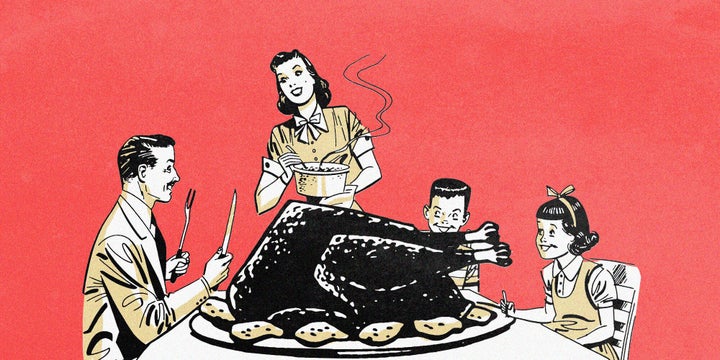Everything Thanksgiving: Get all our Thanksgiving recipes, how-to’s and more!
How much damage are we doing with our epic Thanksgiving meal every year? We spoke with three researchers to find out more about Thanksgiving’s carbon footprint.
It turns out that your food isn’t the biggest holiday culprit of carbon dioxide emissions — traveling for the meal is.
No one should be discouraged from enjoying the holiday or celebrating with family and friends, but we’re here to provide insight into the ingredients and dishes that have the largest ecological impact. The researchers we interviewed shared suggestions and alternative ingredients that cause less environmental damage.

Consider Taking The Turkey Out Of The Turkey Dinner
Meat and meat byproducts (cheese, butter and heavy cream, for example) have a larger environmental footprint than plant-based ingredients. According to research done by Carnegie Mellon University, the carbon footprint of a 16-pound turkey creates a total of 34.2 pounds of CO2 — the same amount produced by turkey gravy, cranberry sauce, roasted Brussels sprouts, mashed potatoes, rolled biscuits and apple pie combined. But Paul Fischbeck, who worked on the study and a professor in Carnegie Mellon’s department of Social and Decision Sciences, noted that turkey is better than other meat, such as beef: “Turkeys themselves are pretty efficient in getting them grown.”
“The carbon footprint of a 16-pound turkey is the equivalent of one dish of turkey gravy, cranberry sauce, roasted Brussels sprouts, mashed potatoes, rolled biscuits and apple pie combined.”
Looking for a lower carbon alternative? Go for a plant-based source. Dietician Kate Geagan, the author of “Go Green Get Lean,” notes that “plant-based foods consistently have been shown to have lower carbon footprints ― so those walnuts, chestnuts, mushrooms, etc. are far more efficient to produce in total resources than conventional animal products, especially red meat.”
Want to get into the nitty gritty? On the hierarchy of vegetables, asparagus and celery produce the highest quantity of CO2 per pound, with 7.33 and 7.09 respectively. They’re still much better for the planet than the turkey, but squash and pumpkin only create 0.10 and 0.11 pounds of CO2 per pound, respectively. So instead of more turkey, help yourself to an extra slice of pumpkin pie or an additional serving of squash soup.
Buy Locally Sourced Ingredients To Minimize Their Travel
Exotic or specialty ingredients (like artisanal cheeses from Europe or out-of-season fruits from South America) can also be a major culprit of excess CO2 emissions, due to the energy expended transporting them.
“Four people flying a 600-mile trip is the equivalent of 10 times the CO2 emissions of the Thanksgiving meal.”
Try sourcing your ingredients locally to limit your impact, from the wine you serve to the herbs that are stuffed into your bird. The benefits of lessening your food miles are numerous, not just in terms of decreasing your carbon footprint, but because then you’re supporting your local economy and increasing the quantity of nutrients in your food. But don’t beat yourself up too much if you can’t source all your ingredients locally. As Liz Goodwin, senior fellow and director of food loss and waste at World Resources Institute notes, that the miles travelled by food are only a part of the equation. She told HuffPost, “food miles are complicated by other things as well, e.g. food production in developing countries provides a source of income and potentially a livelihood for the farmers in that country. However, all other things being equal, it would be better to eat things grown closer to home.”
The biggest carbon impact is caused by people, not food, traveling extensive distances. Researchers at Carnegie Mellon determined that four people flying a 600-mile trip produces 10 times the emissions of the Thanksgiving meal. Driving is less detrimental, but American cars emit close to a pound of CO2 per mile driven. Orchi Banerjee, a recent graduate of the department of Social and Decision Sciences at Carnegie Mellon, said, “It may help the environment if [your guests] stayed home and cooked their own meal.”
And Then There’s The Issue Of Food Waste
While Thanksgiving is a time of abundance and celebration, another area to be conscious of is food waste. According to the USDA, 30 to 40% of America’s food supply is wasted, making a good argument for pairing down the endless sides and apps and selecting a few key dishes to ensure more is eaten. Geagan also recommends “eating the whole vegetable, [from] root to tip to minimize waste.” Some simple examples include making a beet hummus as a starter and using the beet greens as a braised side, or keeping the tops of carrots and pureeing them into a pesto.
The takeaway? Thanksgiving is a time of gratitude and family for many people. Some simple recommendations for your meal include choosing a smaller turkey or ensuring that fewer ingredients are sourced from great distances. Celebrating with friends and family locally or finding a spot that requires less travel for everyone are a few ways to lessen your impact on the environment while celebrating the holiday.